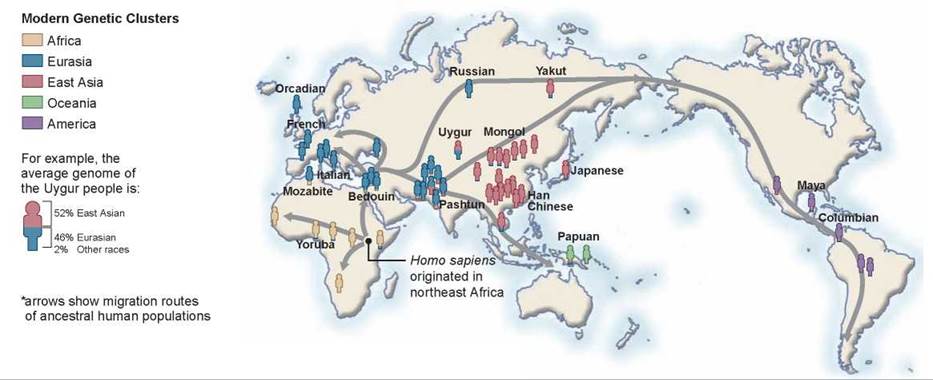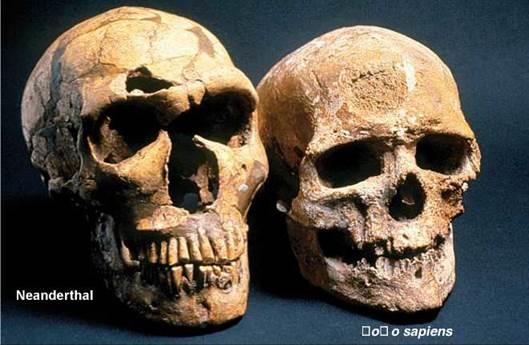THE LIVING WORLD
Unit Five. Evolution of Animal Life
21. How Humans Evolved
21.8. The Only Surviving Hominid
The Neanderthals (classified by some as a separate human species, H. neanderthalensis) were named after the Neander Valley of Germany, where their fossils were first discovered in 1856. The closest evolutionary relatives of present-day humans, Neanderthals were common in large parts of Europe and Western Asia 70,000 years ago. The Neanderthals made diverse tools, including scrapers, spearheads, and hand axes. They lived in huts or caves.
In 2010, the bulk of the Neanderthal genome was determined using fragments of DNA extracted from fossil bones of three Neanderthal females who lived in Croatia more than 38,000 years ago. The genome sequence confirms that the Neanderthals have quite different DNA than Homo sapiens, supporting the view that Neanderthals were a separate species. Interestingly, comparing this composite Neanderthal genome with the complete genomes of five living humans from different parts of the world, both European and Asian H. sapiens today contain about 1% to 4% of sequences inherited from Neanderthals. This offers the tantalizing suggestion that early modern humans may have interbred with Neanderthals! Although the degree of gene sharing is slight, this suggestion that each of us carries a few Neanderthal genes is sure to provoke controversy.
Fossils of H. neanderthalensis abruptly disappear from the fossil record about 34,000 years ago and are replaced by fossils of H. sapiens called the Cro-Magnons (named after the valley in France where their fossils were first discovered). We can only speculate why this sudden replacement occurred, but it was complete all over Europe in a short period. There is some evidence that the Cro-Magnons came from Africa— fossils of essentially modern aspect, but as much as 100,000 years old, have been found there.
The Cro-Magnons used sophisticated stone tools, had a complex social organization, and are thought to have had full language capabilities. They lived by hunting. The world was cooler than it is now—the time of the last glaciation—and Europe was covered with grasslands inhabited by large herds of grazing animals.
Humans of modern appearance eventually spread across Siberia to North America, which they reached at least 13,000 years ago, after the ice had begun to retreat and a land bridge still connected Siberia and Alaska. By 10,000 years ago, about 5 million people inhabited the entire world (compared with over 6 billion today). A genomic survey of world populations carried out in 2002 (figure 21.10) provides clear evidence of the migration of our species out of Africa and across the globe. As discussed on the facing page, people cluster into five distinct groups that correspond to the populations living today on the five continents. Population-specific evolutionary changes seen in DNA comparisons include genes related to sucrose metabolism in East Asians, to skin pigmentation and lactose tolerance in Europeans, and in the metabolism of the sugar mannose in Africans. Clearly, humans are still evolving, locally.

Figure 21.10. Homo sapiens is still evolving.
Researchers comparing the DNA genomes of 52 modem human populations have discovered five main genetic clusters, which largely correspond to major geographic regions.
Homo sapiens Are Unique
We humans are the current stage of a long evolutionary history. The evolution of our genus has been marked by a progressive increase in brain size. While not the only animal capable of conceptual thought, we have refined and extended this ability until it has become the hallmark of our species. We control our biological future in a way never before possible—an exciting potential and frightening responsibility.
Key Learning Outcome 21.8. Our species, Homo sapiens, is good at conceptual thought and tool use and is the only animal that uses symbolic language. H. sapiens continues to evolve.
Today’s Biology
Race and Medicine
Few issues in biology have stirred more social controversy than race. Race has a deceptively simple definition, referring to groups of individuals related by ancestry that differ from other groups, but not enough to constitute separate species. The controversy arises because of the way people have used the concept of race to justify the abuse of humans. The African slave trade is but one obvious example. Perhaps in some measure responding to these sorts of injustice, scientists have largely abandoned the concept of race except as a social construct. In 1972 geneticists pointed out that if one looked at genes rather than faces, the differences between the genes of an African and a European would be hardly greater than the difference between those of any two Europeans. For 38 years, gene data has continually reinforced the validity of this observation, and the concept of genetic races has been largely abandoned.
Recent detailed comparisons of the genomes of people around the world reveal that particular alleles defining human features often occur in clusters on chromosomes. Because they are close together, the genes experience little recombination over the centuries. The descendants of a person who has a particular combination of alleles will almost always have that same combination. The set of alleles, technically called a "haplotype,” reflects the common ancestry of these descendants from that ancestor.
Ignoring skin color and eye shape, and instead comparing the DNA sequences of hundreds of regions of the human genome, investigators have compared the haplotypes of a large sample of people from around the world. They found five large groups containing similar clusters of variation: Europe, East Asia, Africa, America, and Australasia. That these are more or less the major races of traditional anthropology is not the point. The point is that humanity evolved in these five regions in isolation from one another, that today each of these groups is composed of individuals with a shared ancestry, and that by analyzing the DNA of an individual we can deduce that ancestry.
Why bother making that rather arcane and socially controversial point? Because analysis of the human genome is revealing that many diseases are influenced by alleles that have arisen since the five major branches of the human family tree separated from one another, and are much more common in the human ancestral group within which the DNA mutation causing the disease first occurred. For example, a mutation causing hemochromatosis, a disorder of iron metabolism, is rare or absent among Indians or Chinese, but very common among northern Europeans (it occurs in 7.5% of Swedes), who also commonly possess an allele leading to adult lactose intolerance (inability to digest lactose) not common in many other groups. Similarly, the hemoglobin S mutation causing sickle cell disease is common among Africans of Bantu ancestry, but seems to have arisen only there.
This is a pattern we see again and again as we compare genomes of people living in different parts of the world—and it has a very important consequence. Because of common ancestry, genetic diseases (disorders that are inherited) have a lot to do with geography. The risk that an African American man will be afflicted with hypertensive heart disease or prostate cancer is nearly three times greater than that for a European American man, while the European American is far more likely to develop cystic fibrosis or multiple sclerosis.
These differences in DNA variants carry over to genetic differences in how individuals respond to treatment. African Americans, for example, respond poorly to some of the main drugs used to treat heart conditions, such as beta-blockers and angiotensin enzyme inhibitors.
Scientists and doctors that recognize this unfortunate fact are not racists. They fully agree that while using the races of traditional anthropology to pin-point which therapeutic treatment to recommend is an improvement over treating all patients alike, it is still a very poor way of getting at these differences. It would be far better to simply ignore skin color and other single-gene differences and instead perform for each patient a broad "gene variation” analysis. Hopelessly difficult only a few years ago, this now seems an attractive avenue to improve medical treatment for all of us.
It is important to keep clearly in mind the goal of sorting out individual human ancestry, which is to identify common lines of descent that share common response to potential therapies. It is NOT to assign people to overarching racial categories. This point is being made with great clarity in a course being taught at Pennsylvania State University, where about 90 students had their DNA sampled and compared with four of the five major human groups. Many of these students had thought of themselves as "100% white,” but only a few were. One "white” student learned that 14% of his DNA came from Africa, and 6% from East Asia. Similarly, "black” students found that as much as half of their genetic material came from Europe, and a significant amount from Asia as well.
The point is, rigid ideas about the biological basis of identity are wrong. Humanity is much more complex than indicated by a few genes affecting skin color and eye shape. The more clearly we can understand that complexity, the better we can deal with the medical consequences, and the great potential that human diversity provides all of us.

Inquiry & Analysis
Has Brain Size Increased as Hominids Evolved?
As noted in this chapter, brain size has become progressively larger as hominids evolved. Interestingly, Neanderthal fossils (left in the photo below) typically have larger brains than fossils of modern humans (right in photo below), about 1,650 cubic centimeters (cc) for Homo neanderthalensis versus about 1,500 cc for H. sapiens. Does this suggest that Neanderthals were smarter than us?
The graph to the right explores the evolution of hominid brain size by plotting the age of each major type of hominid versus its brain size (that is, the volume of the skull cranium's interior). For each type of hominid, there is some variation in cranial volume among the fossils that have been described, and a typical value is presented (the number in parentheses by each point).
The value for H. neanderthalensis, for example, is plotted as a typical 1,650 cc, even though a skull found in the Amud cave of Israel (see page 459) is 90 cc larger. Some paleontologists consider H. ergaster to be a variant of H. erectus, and H. heidelbergensis and H. neanderthalensis to be variants of H. sapiens, but for the sake of this analysis, the "splitters” view is presented. While the question used to be controversial, most anthropologists now feel that H. neanderthalensis and H. sapiens are separate species, both descended from H. heidelbergensis (however it is named).

1.Applying Concepts. In the graph, what is the dependent variable?
2. Interpreting Data
a. Which human species of Homo has the biggest brain? The smallest?
b. Which australopithecine has the biggest brain? The smallest?
c. Does any australopithecine have a brain as large as a human?
3. Making Inferences
a. Over 2 million years, does the brain size of australopithecines change? How much? What percent increase is this?
b. Over 2 million years, does the brain size of humans change? How much? What percent increase is this?
4. Drawing Conclusions
a. Does brain size appear to have evolved faster in the genus Homo than in the genus Australopithecus? How much faster?
b. Given the clear and undisputed larger brain size of Neanderthals, and the conclusion you have drawn in 4a, does this allow you to further conclude that Neanderthals were smarter than today's humans?
5. Further Analysis. What key unverified assumption does this conclusion depend upon? If you do not accept this further conclusion, why then do you think brain size has evolved as rapidly as it has in the genus Homo?

1. Although many mammals have binocular vision, the anatomical adaptation(s) that set primates apart from these mammals is/are
a. prehensile tails.
b. opposable digits on hands.
c. mammary glands.
d. hair-covered skin.
2. The earliest humans were thought to have evolved in
a. Africa.
b. Asia.
c. Australia.
d. Europe.
3. Anthropoids are primates that include all of the following except
a. monkeys.
b. apes.
c. lemurs.
d. humans.
4. Which of the following anatomical characteristics of hominids contributed to bipedalism?
a. longer and heavier lower limbs
b. curved vertebral column
c. bowl-shaped pelvis
d. All of the above.
5. What feature appeared first in early human ancestors?
a. language
b. increased brain size
c. tool use
d. bipedalism
6. A characteristic used to differentiate between Australopithecus and Homo is
a. brain size.
b. presence in Africa.
c. walking upright.
d. All of these are correct.
7. Some scientists believe the first hominid to be
a. Australopithecus boisei.
b. Australopithecus anamensis.
c. Australopithecus afarensis.
d. Australopithecus robustus.
8. Which of the following most closely resembles the australopithecines?
a. Homo sapiens
b. Homo heidelbergensis
c. Homo neanderthalensis
d. Homo habilis
9. The first hominid to migrate extensively to Europe and Asia was
a. Homo sapiens.
b. Homo heidelbergensis.
c. Homo neanderthalensis.
d. Homo erectus.
10. DNA and chromosomal studies seem to indicate that Homo sapiens originated in
a. many different regions, wherever Homo erectus was found.
b. Africa.
c. Asia.
d. Europe.